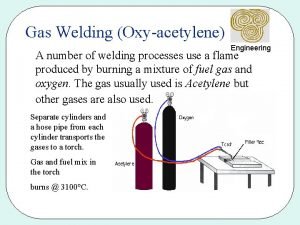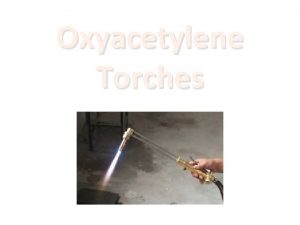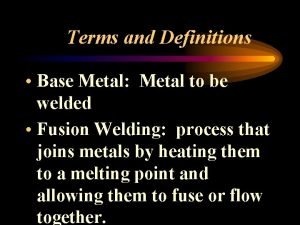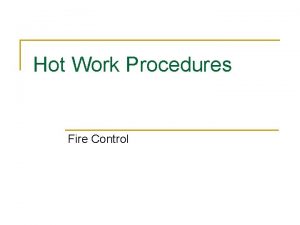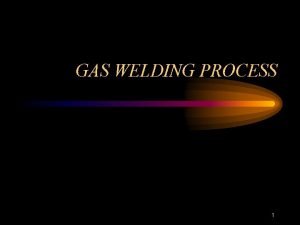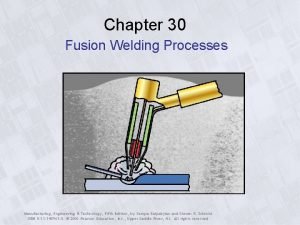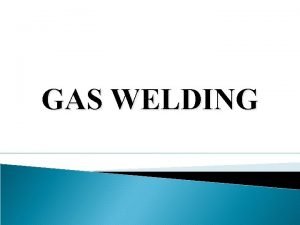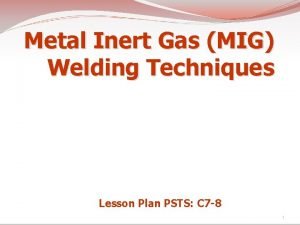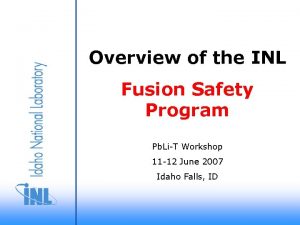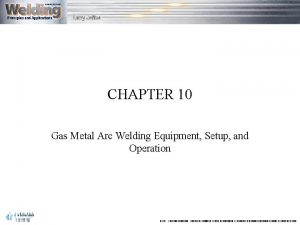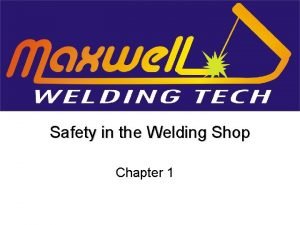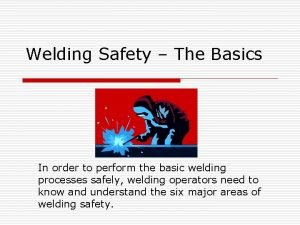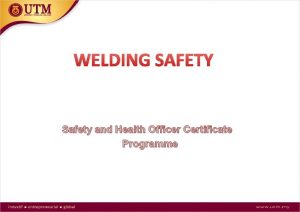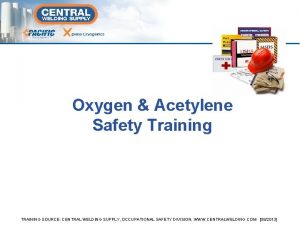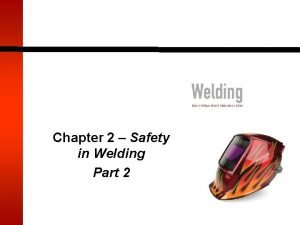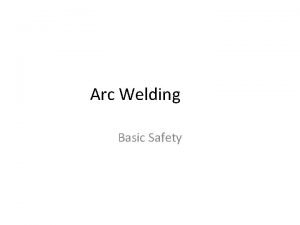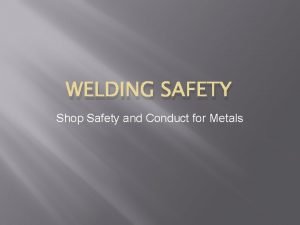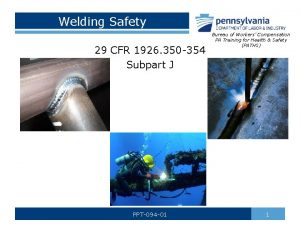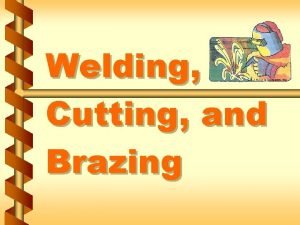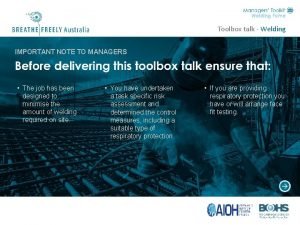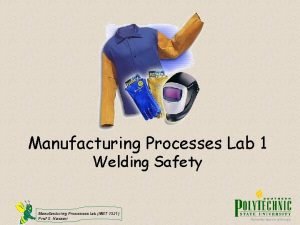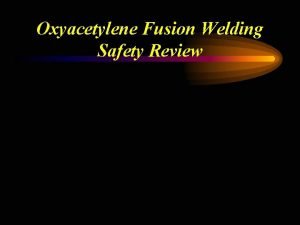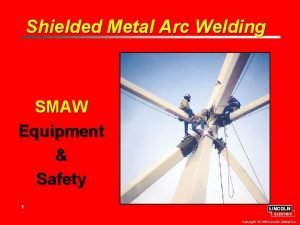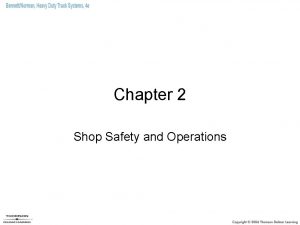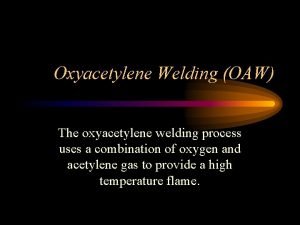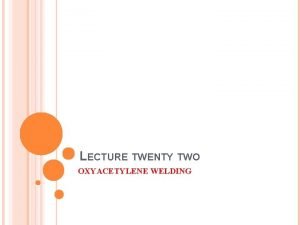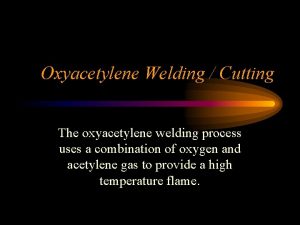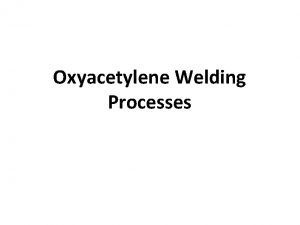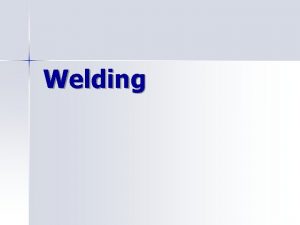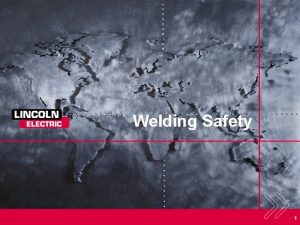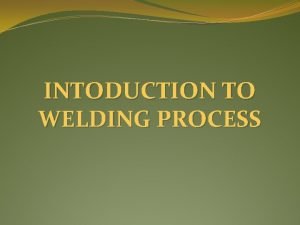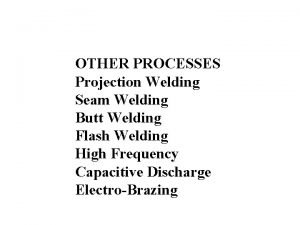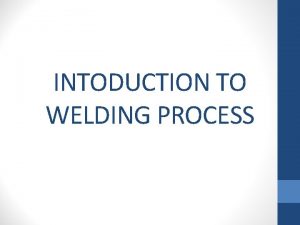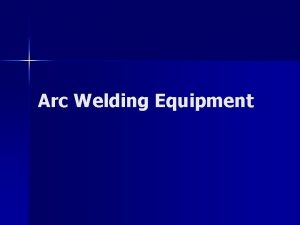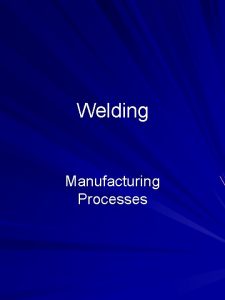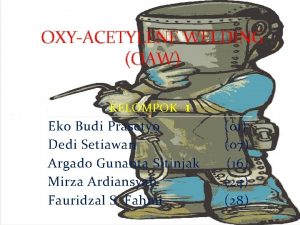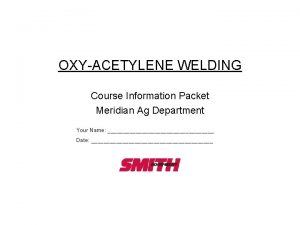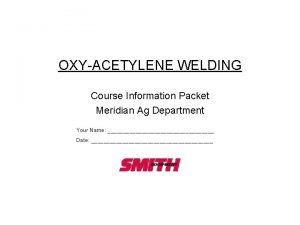Oxyacetylene Fusion Welding Safety Review Safety Rules for














































- Slides: 46

Oxyacetylene Fusion Welding Safety Review

Safety Rules for Oxyacetylene Equipment • Support oxygen and acetylene cylinders in an upright position so they can not be tipped over – Acetylene gas is in a liquid state in the cylinder and should be used in a vertical position so the acetone will not be withdrawn. • Acetylene is shock-sensitive and could explode if it was allowed to splash freely in a cylinder. • Acetone is used to help stabilize the acetylene.

• Blow out cylinder valves in order to remove dust and dirt before attaching regulators. • This is referred to as “cracking” the valve

• Release pressure adjusting screw on regulator before opening cylinder valve. • This prevents damage to the regulator and possible injury to the operator. • Always stand to the side of the regulators when open them. Do not stand in front of or behind the regulators.

• Open the cylinder valves slowly. • Do not use acetylene at pressures greater than 15 psi. • Acetylene becomes unstable at pressures greater then 15 psi and becomes highly explosive.

• Purge acetylene and oxygen passages individually before lighting the torch in the respective order. • Always light the acetylene before opening the oxygen torch valve.

• Never use grease or oil on regulators, torches, or fittings. • Oil or grease and oxygen have a very great attraction for one another and will unite with explosive violence.

• Do not use oxygen as a substitute for compressed air. • Always wear safety glasses, gloves, protective lenses and protective clothing. • Always know the locations and use of fire extinguishers. Have one available for use when welding.

• If a system is loosing pressure, a leak may be present. • Turn on the system and leave pressure on regulators and hoses to verify a leak. • Test connections for leaks with soapy water to find the defective part or loose connection.

• Avoid lighting a torch or cutting near combustible materials. • Never open the acetylene valve more than 1/2 to 3/4 turns. • Always operate a torch in a well ventilated area.

• Never cut on containers that have been used for combustible materials. • Never cut on a sealed container without a vent hole opposite the initial cut hole.

• Avoid breathing toxic fumes when cutting or welding. • All welding processes give off fumes which can be hazardous. • Galvanized metal gives off toxic fumes.

• Place steel caps on all gas cylinders when they are being moved or stored to protect the valves. • Oxygen is a great danger because of the high pressure it is filled to. • Capable of going through 8 cement block walls if valve is broken off.

• Shut off cylinder valves when not in use for any length of time to reduce the possibility of leakage and strain on the equipment. • Turn off the acetylene torch valve first to extinguish the flame immediately. • Keep hands, gloves and clothing free from grease and oil when using oxy-acetylene equipment.

• Never cut or weld close to concrete or blacktop surfaces. • Always cut or weld at least 5 feet from the cylinders. • Always protect hoses from hot sparks, metal, ruptures or mechanical damage. • Always use a friction lighter (striker) to light a torch.

• Never leave a burning torch unattended. • A burning torch must always be handled. Never lay it down. • All tanks must be chained when in use or in storage. • When removing tanks from a set-up, always place a protective cap on the tank before removing it.

Oxyacetylene Fusion Welding Flames • • Carburizing Flame contains excess of acetylene recommended flame for cutting cast iron introduces carbon into weld, causing hardening of the metal, resulting in a weak weld

• Neutral Flame • burns equal amounts of oxygen and acetylene • identified by clear, well defined white cone • temperature 5950 degrees Fahrenheit

• • Oxidizing Flame burns an excess of oxygen identified by a short white inner cone oxidizes the metal causing it to harden and become brittle • not recommended for average cutting • a slightly oxidizing flame is recommended for brazing

Oxyacetylene Fusion Welding Flames

Welding Techniques

Welding Procedures • Fore-hand welding • Used for most metals up to 1/8 inch thick

• Back-hand welding • Used for metals thicker than 1/8 inch

Welding Patterns • Circular

• Crescent

• Figure 8

The Do’s of Oxyacetylene Welding • Take precaution in moving full cylinders. Use cylinder caps. • Keep oxygen away from oil and grease. • Always “crack” cylinders before attaching regulators. • Open valve on cylinder slowly after attaching regulator.

• Before lighting the torch, make sure all connections are clean and tight. • When regulator is not in use, the regulator adjusting screw should be turned out until the diaphragm is free. • When the torch flashes back or is burning on the inside, turn off the oxygen first and then both cylinders.

• • Causes of flashback Holding the torch too close to the work. The tip is not clean. Oxygen or acetylene pressure is not set properly the tip size you are using.

• Precautions should be taken to prevent the hoses from rupture or from mechanical damage. • Always close the cylinders and release the pressure from the regulators and hoses when your work is done. • This is done at the end of the class period, so as not to waste gases from repeated draining.

• Extra tips should be put away when not in use. Never put them in a drawer or with other tools as they may damage the seat of the tip. • Always use the right size tip for welding and cutting. • Always turn on the oxygen cylinder valve on all the way - so as to “seat “ the valve.

• Keeps the both cylinder in an upright position. • Always mark the cylinders that have been emptied, or put the in the appropriate place. • Always place the welding tip so it points to the same side of the torch that the acetylene hose is attached. • Always close both acetylene and oxygen torch valves when done welding or cutting.

The Don’ts of Oxyacetylene Welding • Do not use oil or grease on oxygen or acetylene connections. • Never open cylinders until you are certain the regulator adjusting screws are loose. • Never open the valves on cylinders with a hammer. • Never hammer on oxygen or acetylene regulators.

• Do not light a torch with anything other than a striker. Never use a match or lighter. • Before lighting a torch, be positive that hoses, cylinders, and other flammable materials will not be exposed to heat, flames or sparks. • Be aware of acetylene pressure. It should never be used greater than 15 psi.

• Acetylene becomes highly explosive when compressed to more than 15 psi. • Never turn in the adjusting screw too far, as this will damage the diaphragm. If the line pressure drops, check the pressure at the regulator--the cylinder may be empty.

• Do not hold the torch tip too close to the work, as this will cause a flashback in your torch. • Never use a tip that gets overly hot. • Never use a torch that leaks. • Never leave torch valves open when not in use.

• Never cut or weld too close to concrete or blacktop…use a fire brick. • Do not store cylinders in a room where the temperature in above 80 degrees Fahrenheit. • Do not experiment with the welding equipment. Use it properly.

• Never attempt to weld close containers holding flammable fumes. • Never weld with butane lighters or other flammables in your pocket. • Never tighten torch handles with a wrench. • Never use any thing else to open an acetylene cylinder valve except the appropriate wrench. • Always keep acetylene wrench in place on tank.

• Never reach when gas welding…no one can anticipate your movements and you may get severely burned.

Proper Start-up Procedures • Check both regulator adjusting screws to make sure they do not have pressure on them. • Crack open the cylinder valve on the acetylene tank and open valve 1/2 turn. • Crack open the cylinder valve on the oxygen and open all the way.

• Open the acetylene torch valve about 1/8 of a turn. • Turn in regulator adjusting screw until pressure is set. (4 to 5 psi. ) • Close the acetylene torch valve.

• Open the oxygen torch valve about 1/8 turn. • Turn in the regulator adjusting screw until pressure is set. (4 to 5 psi for welding, 35 to 40 psi for cutting. ) • Close the oxygen torch valve. • Open the acetylene torch valve about 1/8 turn and light the acetylene with a striker. • Add oxygen with the torch valve until the desired flame is achieved.

• For cutting, the additional must be completed. • First, change to cutting head if not already done. • Open the oxygen torch valve all the way. • Set up tanks using the same procedure for start-up. • Open the oxygen preheat valve, and set working pressure to 35 to 40 psi.

• Close the oxygen preheat valve. • Light acetylene using the same as procedure for gas welding. • Add oxygen with preheat valve to accomplish a neutral flame. • Depress the oxygen cutting valve all the way. • Fine tune the flame using the preheat valve to simulate a neutral flame when cutting.

Proper Shut-down Procedures • • • Turn off acetylene torch valve. Turn off oxygen torch valve. Turn off acetylene tank valve. Turn off oxygen tank valve. Open acetylene torch valve and wait until the working pressure and tank pressure gauges to reach zero. • Close acetylene torch valve.

• Open oxygen torch valve or preheat valve on cutting head and wait until the working pressure and tank pressure gauges reach zero. • Close the oxygen torch valve or preheat valve on cutting head. • Turn out acetylene adjusting screw until pressure is released from diaphragm. • Turn out oxygen adjusting screw until pressure is released from diaphragm.
 Introduction of gas welding
Introduction of gas welding Oxyacetylene is a combination of
Oxyacetylene is a combination of Safety terms and definitions
Safety terms and definitions The correct shutoff procedure for an oxyacetylene torch is:
The correct shutoff procedure for an oxyacetylene torch is: Define oxy acetylene welding
Define oxy acetylene welding Tig (tungsten inert gas)
Tig (tungsten inert gas) Draglines welding definition
Draglines welding definition In a fusion welding process mcq
In a fusion welding process mcq Disadvantages of gas welding
Disadvantages of gas welding Fusion arc welding
Fusion arc welding What is fusion welding process
What is fusion welding process Corner joint weld symbol
Corner joint weld symbol Welding lesson plans
Welding lesson plans Fusion safety management
Fusion safety management Gmaw power supplies are
Gmaw power supplies are Welding shop safety
Welding shop safety Welding safety precautions
Welding safety precautions Smaw safety
Smaw safety Chapter 2 welding safety quiz
Chapter 2 welding safety quiz Welding safety precautions
Welding safety precautions Chapter 2 safety in welding
Chapter 2 safety in welding Welding safety precautions
Welding safety precautions Welding shop safety
Welding shop safety 29 cfr 1926
29 cfr 1926 Welding safety program
Welding safety program Welding safety toolbox talk
Welding safety toolbox talk Welding safety
Welding safety Welding safety toolbox talk
Welding safety toolbox talk Gas welding safety tips
Gas welding safety tips Smaw tools
Smaw tools Chapter 2 shop safety
Chapter 2 shop safety Kontinuitetshantering i praktiken
Kontinuitetshantering i praktiken Typiska drag för en novell
Typiska drag för en novell Nationell inriktning för artificiell intelligens
Nationell inriktning för artificiell intelligens Returpilarna
Returpilarna Varför kallas perioden 1918-1939 för mellankrigstiden?
Varför kallas perioden 1918-1939 för mellankrigstiden? En lathund för arbete med kontinuitetshantering
En lathund för arbete med kontinuitetshantering Särskild löneskatt för pensionskostnader
Särskild löneskatt för pensionskostnader Personlig tidbok för yrkesförare
Personlig tidbok för yrkesförare A gastrica
A gastrica Förklara densitet för barn
Förklara densitet för barn Datorkunskap för nybörjare
Datorkunskap för nybörjare Tack för att ni lyssnade bild
Tack för att ni lyssnade bild Att skriva en debattartikel
Att skriva en debattartikel Magnetsjukhus
Magnetsjukhus Nyckelkompetenser för livslångt lärande
Nyckelkompetenser för livslångt lärande Påbyggnader för flakfordon
Påbyggnader för flakfordon
